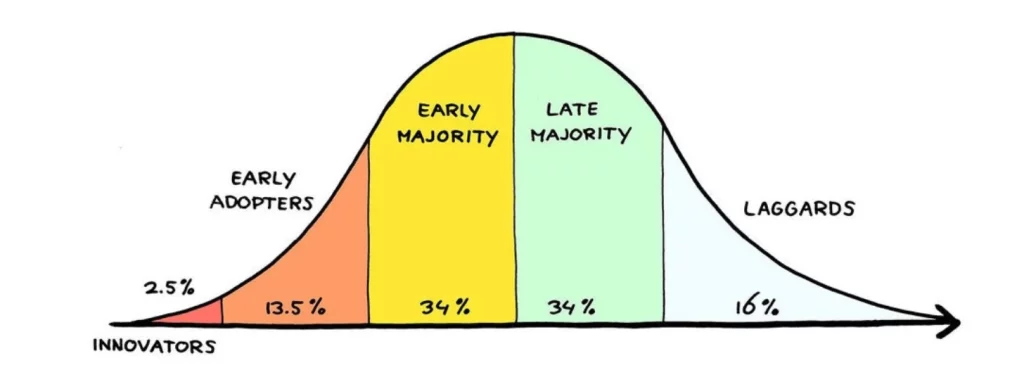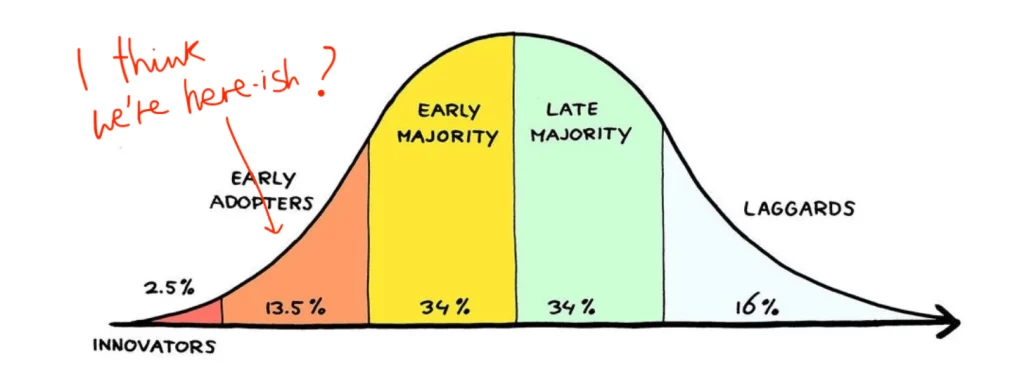
Welcome to contentfolks—a fortnightly newsletter with short lessons & ideas about content that makes a difference, sparks action, and truly serves its audience. Thank you for being here!
Hey 👋
Guess what turned one last Thursday? This here newsletter 🎂 🎉 🥳
But we’ll celebrate at the end—let’s talk about content stuff first.
Are you an innovator or a laggard? 2
The diffusion of innovations theory suggests that new ideas, products, and technologies gain momentum and spread in five consecutive stages:

If you work in B2B or a startup, I’m 76% sure you’ve met this chart before.
And if you haven’t, here is a quick summary:
- Innovators are the most willing to give a new product or technology a try as soon as it’s out, despite its potential flaws, and won’t require much convincing (e.g. the 300,000 people who bought an iPad on its first day of availability)
- Early adopters are not as fast as innovators but still get curious fairly early on, especially with some social proof and momentum (e.g. the 15million people who bought an iPad in its first year of existence)
- The early majority adopts new ideas before the average person, but wants to see evidence that the new product or technology works before committing to it
- The late majority is sceptical of change, and will adopt an innovation after it has been tried and tested by the majority
- Laggards are the most change-resistant, need a lot of convincing, and are the hardest group to bring on board (e.g. me never buying an iPad)
You can use this curve to plot the adoption of most products, from COVID vaccines to Teslas to kale chips. But you may also use it to understand where your content audience is, so you can better serve it—for example: what if most of what you do is created with innovators in mind, but your audience has shifted towards early adopters?
💡 A practical example 💡
Take a look at this newsletter’s adoption curve:
- A year ago, issue #1 went out to ~200 innovators who had no idea what it was going to be like, but gave it a try anyway when they heard me talk about it.
- Throughout 2021, social proof started to appear, I got invited to content marketing podcasts, people mentioned contentfolks to their networks, more issues got shared, and slowly but steadily ~1300 early adopters joined.

How is this information useful? It tells me that:
- I need to do a round of audience research → most of the early ~200 were in my immediate network of in-house marketers at B2B startups; now there are a lot of you who may have a different background and unique content problems to solve—and I’d like to know what they both are
- I should probably make a few tweaks → for example, add some context for anyone who doesn’t know who I am. Maybe a little social proof? Links to my LinkedIn profile? Something else?
An easy way to solve for 1 and 2 at once would be setting up a survey with questions that help me get a better sense of who you are + what I should tweak…
…which is exactly what I decided to do 😉
You are hereby officially invited to take contentfolks’ first-ever audience survey. Can you spare ~5 mins to fill it in today?
In exchange for your help, I’ll use an upcoming issue to explain why I picked each question, share the results, and show you how I’ll use them.
Deal?
I often talk about the importance of having a strategy and a plan, but I’ll happily admit that back in the autumn of 2020 I didn’t have much of either, on purpose.
After leaving a job of ~4 years, I mostly wanted to regroup for a bit, build connections, share what I’d been learning, and see where that would take me.
And one of the places that took me was… right here, in this newsletter, with you! Thank you for being here. Whether you joined contentfolks one year or one minute ago, I appreciate you ❤️

PS: haven’t I convinced you earlier? Come on, give contentfolks a birthday present and take the survey!